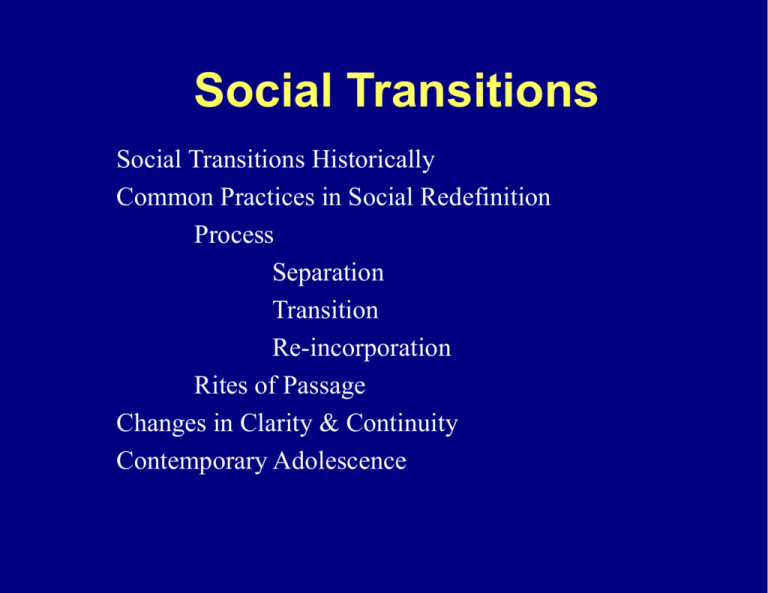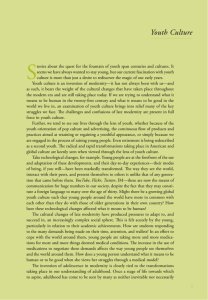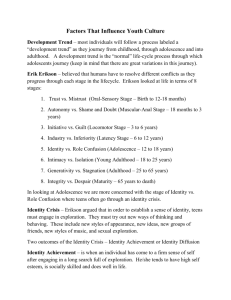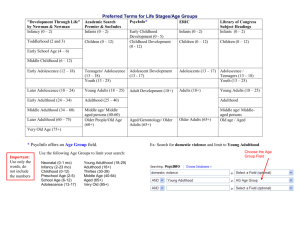
Social Transitions
Social Transitions Historically
Common Practices in Social Redefinition
Process
Separation
Transition
Re-incorporation
Rites of Passage
Changes in Clarity & Continuity
Contemporary Adolescence
Socialization is…
The process by which people acquire the
behaviors and beliefs of their culture
Socialization Outcomes
1. Self-regulation – ability to comply with social
norms
2. Role preparation – for roles in work, gender,
institutions such as marriage, parenthood
3. Cultivation of sources of meaning – “what’s
important?” “What’s to be lived for?”
Adolescence as a Social Invention
• Adolescence defined primarily by being
distinct from childhood or adulthood, not
by cognitive and biological changes
• Inventionists stress that because we
perceive adolescence as distinct, it exists
as a distinct period of the lifespan
– Relative to other cultures and historical periods
– Problems experienced during adolescence may
be due to society’s definition of adolescence, not
cognitive or biological changes
Adolescence as a Social Invention
• Roots in the Industrial Revolution
• Young people excluded from labor force
– Economic dependence on elders
• Formal schooling is lengthened
• New Terminology
– Teenager
– Youth
– Emerging adulthood
Emerging Adulthood
• Arnett’s (1998) term for ages 18-25 caught
between adolescence and adulthood,
characterized by:
– Exploring possible identities before making
enduring choices
– Unstable work, romantic relationships, and living
situations
– Focus on oneself and independent functioning
– Subjective feeling of being caught between
adolescence and adulthood
– Subjective feeling that life holds many possibilities
Social Redefinition
• A time of change in social roles and
status
• How society defines adolescence
– Contemporary society vs. traditional
cultures
• Implications for development
– Identity, autonomy, responsibility, intimacy,
sexuality, achievement
Social Redefinition and
Psychosocial Development
• Identity
– Attainment of adult status causes adolescent to feel more adult-like
• Autonomy
– Adult status leads to shifts in responsibility, independence, and
freedom
• Intimacy, dating and marriage
– Need for new decisions about sexual activity
• Achievement
– Becoming a full-time employee; leave school of their own volition
The Process of Social
Redefinition
• Contemporary America: Movement through
a series of status transitions with a cohort
over a period of years
–
–
–
–
–
Driving, purchasing alcohol, etc.
Generally begins at age 15 or 16
Permission to drive, work, leave school
Voting, age 18
Purchasing alcoholic beverages, age 21
• Timetable is affected by economics, politics,
and culture
The Process…
• Three themes:
–Separation
–Transition
–Reincorporation
The Process…
• Separation
– Extrusion: Real or symbolic separation
from parents
Social Redefinition:
Three Major Components
• Transition
– Separation of males and females
• Brother-sister avoidance
– Passing on of cultural, historical, and
practical information
• from the adult generation to the newly
inducted cohort of young people
The Process of Social
Redefinition
• Some societies mark social redefinition of
the young person with a dramatic and
elaborate initiation ceremony called a rite
of passage
• This often marks the beginning of a long
period of training
Social Redefinition:
Rites of Passage
• Cushion emotional disruption
• Anchoring
– Provides a sense of belonging to both individual
and society
• Inform
– Individual and society
– Attempt to provide clarity
Social Redefinition
• Reciprocity
– Privileges and rights in exchange for good
conduct
• Change in status
– Interpersonal
– Political
– Economic
– Legal
Changes in Status
• Two-sided alteration in status
– Given privileges/rights reserved for
society’s adults
– Increased expectations for
• self-management
• personal responsibility
• social participation
Four Major Changes in Status
•
•
•
•
Interpersonal
Political
Economic
Legal
Changes in Interpersonal Status
• Addressed with adult titles
• Maintain new types of social
relationships with
– Parents and elders
– Younger individuals whose status
has not yet changed
• New interpersonal obligations
– Taking care of and setting example
for younger members of family
Changes in Political Status
• More extensive participation in the
community’s decision making
– Voting (U.S. citizens)
– Ceremonial life (Navajo people formal initiation ceremony)
• Expected to serve their
communities in emergency and
train for warfare
Changes in Economic Status
• May own property and maintain control
over their income
– Until age 16, belongs to parents
– Until 18, cannot enter into legal contract like
a car lease
• Age is a prerequisite for employment in
certain occupations
– Child labor laws in the United States
• Expected to pay taxes
Changes in Legal Status
• Ability to participate in activities typically
reserved for adults
– Gambling
– Purchasing alcohol, smoking
– Driving, voting
• Expected to take increased responsibility
for self-management and social
participation
Types of transitions I
• Clarity – explicit markers of beginning
and end of adolescence
– Traditional cultures – ceremonies,
initiations
– Contemporary culture
• Less of an emphasis on attainment of roles
• Arnett (1998) – what defines adulthood?
– Accept responsibility for consequences of actions
– Financially independent
Social Transitions:
The Importance of Clarity
•
Lewin’s “Marginal man”
–
–
•
caught between two cultural systems and feel
alienated by one or both .
threats to identity may lead to higher levels of
deviance, excessive anxiety and psychiatric instability
Contemporary trends in status according to
Arnett:
–
–
–
Less emphasis on attaining a specific role and more
emphasis on self-reliance
Decline in importance of family roles
Similar criteria for males and females, fewer gendertyped role expectations
Social Transitions: Clarity in
Industrialized Societies
• Given the absence of clarity
– People of the same chronological age may feel
more mature or less mature than age-mates
– No clear indication of when adult
responsibilities and privileges begin
• How adolescents view themselves today
– Less emphasis on attainment of specific roles
– Less emphasis on importance of family roles
– Fewer gender role differences
Social Transitions: Clarity
in Traditional Cultures
• Social redefinition is clearly recognized
• Formal initiation ceremony
– Boys: timing of ceremony varies
– Girls: timing usually linked to menarche
– Physical appearance is often changed
(clothing, circumcision)
• Adults clearly differentiated from
children
Social Transitions:
Clarity in Previous Eras
• Baby boom generation (1950s-1960s)
– Finishing school, moving out, getting married
all occurred early and within narrow timeframe
• Transition in the early 19th century was
more disorderly and prolonged (like today)
– School – viewed as children
– Work – viewed as adults
– Timetable depended on household/family
needs
Types of transitions II
• Continuity – smoothness of passage into
adulthood
– Continuous
• Gradual transitions, in which the adolescent assumes
the roles and status of adulthood bit by bit
• Assume new roles a bit at a time with lots of
preparation and training
– Discontinuous
• Sudden transitions, in which the adolescent’s entrance
into adulthood is more abrupt, with little or no training
• Thrust into new roles with little preparation
Continuity and Discontinuity
• Modern society is very discontinuous
– Little preparation for roles of worker, parent,
citizen
• Call to improve “school-to-work transition”
– Youth apprenticeship model
– Options for non-college-bound high school
students
– Make transition more like traditional cultures &
previous eras
Discontinuity
• Socializing of adolescents for adult roles (worker,
parent) – adequate?
• Contributes to psychological and behavioral
problems
– Benedict – creates stress
• Abrupt transitions
– Teenage parents
– School drop-outs
– Moving out of family home
The Transition into Adulthood
in Contemporary Society
Two trends are reshaping the transition
(1) The transition period is getting longer
Puberty occurs earlier and schooling
lasts longer.
(2) Success in the labor force is more
dependent on formal schooling
Contemporary Transitions
• In all societies:
– Adolescence is a period of
social transition
– The individual comes to be
recognized as an adult
• The social transition is less
explicit in contemporary
U.S. society than in
traditional cultures
Osgood, Ruth, Eccles, Jacobs, & Barber (2005)
Historical Comparison of Transition Ages
30
25
Age (years)
20
15
10
5
Leaving formal education
Entrance to peer group and youth culture
Entrance to occupational life
Entrance to marriage and partnership
0
1890
1990
Year
The Transition into Adulthood in
Contemporary Society
•
Adolescents are
living at home
longer than ever
before
– 55% U.S. 20- to 22year-olds
– May be a result of
increased costs of
housing and
transportation










